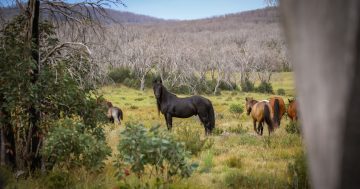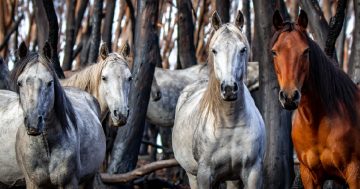
The magnificent Long Plain in the Snowy Mountains will be the site of a brumby supporter rally this weekend. Photo: Supplied.
The grassy expanse known as Long Plain in the Snowy Mountains will be tinged with red this weekend as brumby supporters rally to reject the continued culling of wild horses in the region by the NSW National Parks and Wildlife Service (NPWS).
The rally marks the first substantial NSW challenge to the final plan for managing wild horses in Kosciuszko National Park (KNP), released in late November by then NSW Environment Minister Matt Kean.
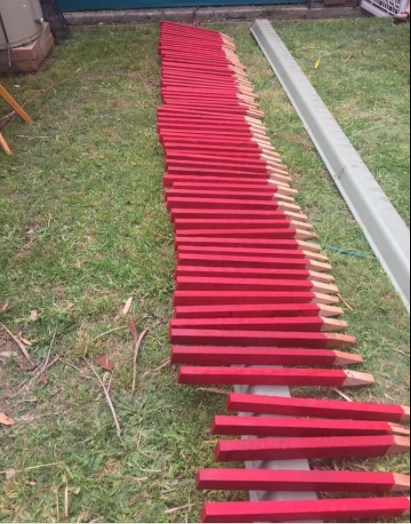
Around 600 red painted wooden pickets have been prepared for the event. Photo: Snowy Mountain Brumby Sustainability Management Group.
Front and centre of the plan is a staged reduction in the overall wild horse population from an estimated 14,380 to 3000 horses by 30 June 2027.
About half of the national park that is currently free of horses will remain so. Horses will be removed from a further 21 per cent of the park but will continue to graze on a third of the park, in places such as Kiandra Plains.
Trapping and rehoming of horses will be one control method, as will ground shooting. Aerial shooting is not part of the plan because of a “significant risk” it would “result in a loss of the social licence to remove wild horses from the national park”.
This, Mr Kean said, struck the right balance between protecting the heritage value of the wild horses and maintaining the exceptional conservation values of our state’s largest national park.
But, at 10:30 am on Saturday 29 January, gates at Long Plain will be flanked by hundreds of red-painted wooden pickets as the rally gets underway.
Snowy Mountain Brumby Sustainability Management Group (SMBSMG) president Diane Hardley said the 500 stakes represented brumbies trapped and removed from KNP and those supporters unable to attend.
“For each $5 stake purchased in recent months we have raised enough money to allow NSW Animal Justice Party (AJP) MLC Emma Hurst to take a flight over the mountains to see the brumbies for herself,” Ms Hardley said.
“Through her first-hand observations and using video footage, Emma will then be able to challenge the false numbers on the floor of parliament and share that information with the new NSW Environment Minister James Griffin.”
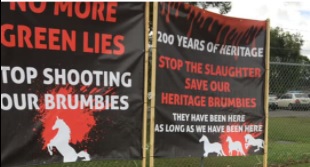
Brumby groups across the nation are starting to unite under one banner. Photo: SMBSMG.
The rally will be addressed by animal protection activist Frankie Seymour, the Animal Justice Party’s candidate for next month’s Monaro by-election, and long-time Tumut resident and historian Rob Collman, who will touch on the brumbies’ heritage.
SMBSMG spokesperson Alan Lanyon said the gathering would inform and educate attendees about brumbies and what he considers to be hyperbole contained in the 2020 Wild Horse Management Plan.
“Attendees at Saturday’s public forum will have the opportunity to take part in a guided tour of the park and will be provided with literature that speaks to the facts about the brumby populations,” he said, “not the misinformation and inflated numbers cited by the government.”
He joins a list of people who have called into question the wild horse population numbers, calculated based on statistical analysis of aerial surveys, used as the basis of the 2021 Kosciuszko National Park Wild Horse Heritage Management Plan.
Mr Lanyon, from Gundagai, has been a long-time witness to the evolving mountain landscape and says, if the culling continues at the rate of 600 wild horses per year, in a few years there won’t be a brumby left in the northern section of KNP.
Having travelled the length and breadth of the park on foot, horseback and in a helicopter, he reckons around 1700 wild horses remain.
He said a recent count from a helicopter in the north of the park found 838 horses.
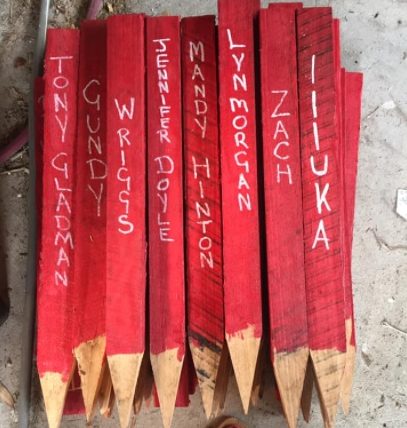
The stakes will be driven into the ground near the entrance to Long Plain before the rally begins on Saturday. Photo: SMBSMG.
“Although clearly some may not have been spotted, it would be impossible for them to have missed 11,673 horses,” he claimed.
The supposed annual wild horse population increase of 37 per cent in the North Kosciuszko area between 2014 and 2019, he says is almost double the accepted scientific maximum.
“This was pointed out in the peer review by St Andrews University and by the minister’s Scientific Advisory Panel (SAP) in their final report and no feasible explanation has ever been given.”
Mr Lanyon said, before any further management was undertaken, it was imperative to know how many horses remain in the park.
He says a new count needed to be undertaken as soon as possible, either using drones and cameras or a spotting count that is done every year by NPWS.
“But,” he argued, “this must involve wild horse advocates.”
Mr Lanyon said Saturday’s rally was about harnessing community power to drive the message forward.





